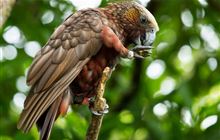GPS project reveals travels of North Island kākā
Archived content: This media release was accurate on the date of publication.
Introduction
Analysis of new data from birds fitted with transmitters has revealed North Island kākā flying long distances and even taking an avian ‘OE’.Date: 04 April 2022
Kākā are a native parrot usually found in ancient forests. They have central North Island strongholds in the Pureora Forest and on offshore islands.
Known for their boisterous antics and raucous socialising in the early morning and late evening, kākā face threats from habitat loss and introduced predators., little has been known about the birds’ seasonal movements.
In a joint project involving DOC and Manaaki Whenua – Landcare Research, GPS and VHF transmitters were fitted to 25 birds near Hamilton and Morrinsville, with flight movements tracked through 2020 and 2021.
“For many years we’ve known about kākā visiting some towns and rural parts of the Waikato over winter – places that don’t look like typical kākā habitat, and a long way from known breeding areas,” says Neil Fitzgerald, Manaaki Whenua Researcher.
“We wanted to find out where these birds were coming from and to try to start to understand why. By identifying important sites and threats we hope to help make their conservation as effective as possible.”
Kākā have been tracked with different gadgets in the past but those devices had limitations, with relatively poor accuracy or being easily lost if a bird moves far from where researchers know to look. The VHF tags used in this work allowed researchers to track the birds for detailed observation of feeding and other behaviour.
“These new GPS tags allow us to see where they go, anywhere in New Zealand, and with accuracy that often allows us to identify which tree they were in,” he says.
“Through winter and early spring, the monitored North Island birds typically stayed within a few kilometres of where they were tagged – as expected. From late spring, 10 moved at least 100 km away, and another six between 35 km and 55 km away.
“One of the things that has surprised me most is, so far, we haven’t tracked any birds to Waipapa Ecological Area, which has a very healthy, relatively close population thanks to years of good control of pest mammals,” says Neil Fitzgerald.
“It illustrates how the movements of highly mobile birds like these are much more complicated than just distance..”
DOC Science Advisor Terry Greene says the GPS data is “another piece in the puzzle in the study and protection of these birds”. There have been reports of kākā appearing in urban environments like Hamilton and Auckland, and it was assumed the birds were from nearby forested areas and island sites. However, the new data from the GPS tracking suggests it’s possible roving kākā embark on a sort of avian OE, “zooming around having a look at the place”.
In the first year several tagged birds went to Hauraki Gulf islands including Kawau, Aotea and Hauturu, while in the second year, birds have stayed more around the Waikato. Of particular interest was one bird fitted with a GPS which completed 1000 km round trip encompassing various points around Waikato, Coromandel and islands in the Hauraki Gulf – a travel distance and behaviour never encountered before in study of kākā.
Kākā are “hugely mobile in the landscape” – as shown by the new research and GPS monitoring – and that has implications for ongoing protection of the species.
“How do we ensure they’re protected as they travel around, and their populations expand? The new information from the GPS study has given us some great new insights into the species, and a lot to think about, too.”
The new research and data suggest some of the birds’ habitats have increasingly higher densities of kākā – particularly in some known mainland environments.
The solar-powered GPS tags sent regular, accurate location data, revealing movements over large distances and potentially long time periods. The tags sit on the birds like a little backpack, with a harness that goes carefully under the wings. When the kākā are released, they tend to test their new accessories for a short time then go back to usual kākā business.
DOC carries out aerial 1080 and ground-based toxin operations to control predators in known kākā habitats like the Pureora Forest. Kākā are classed as “at risk – recovering”.
Contact
For media enquiries contact:
Email: media@doc.govt.nz

